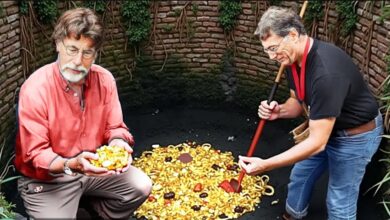The Oak Island Mystery: 200 Years of Buried Secrets (Part 1)
The Oak Island Mystery: 200 Years of Buried Secrets (Part 1)

The first known chapter of the Oak Island mystery begins in the year 1795. At the time, Oak Island was an unassuming patch of wooded land off the southern coast of Nova Scotia, Canada. It sat quietly in Mahone Bay, not far from the small township of Chester. The island was heavily forested, its shoreline ringed with jagged rocks, quiet coves, and the occasional fishing boat drifting lazily along the Atlantic swells.
There were whispers even then of pirates and lost fortunes hidden in these parts of the world, but few paid those legends much mind. The world, after all, was full of stories—and most of them stayed as just that. But one particular story took root on Oak Island that year, thanks to a young man named Daniel McInness.
Daniel was a teenager, likely no more than 16 or 17 years old, and he adventured to the island with two of his friends: John Smith and Anthony Vaughn. It is said that he came ashore with a modest goal—to clear a parcel of land to farm, or perhaps simply to explore, as boys often did in those days, when entire days could pass without the burden of time.
As Daniel walked along the southeastern portion of the island, something peculiar caught his eye. Nestled beneath an old oak tree, he noticed a depression in the ground—a subtle but suspicious sunken spot, almost as if the earth had been tampered with. More curious still, an old pulley block hung from one of the sturdy oak’s thick limbs—a tool often associated with ship rigging or construction.
There were no recent signs of human habitation—no footprints, no tools, and no clear indication of what might have caused the dip in the ground. But to a curious boy with an adventurous heart, the sight sparked imagination. Perhaps, he thought, this was no natural feature. Perhaps there was something buried below.
Excited and likely imagining pirate gold or a secret hiding place, Daniel gathered his companions and returned to the spot the next day. Armed with little more than picks and shovels, the boys began to dig. They did not expect to find much—perhaps a small cache of coins, maybe a buried chest left by a sailor long forgotten.
But what they found was something far stranger.
After digging several feet into the earth, they struck a platform made of thick oak logs. These logs were tightly fitted and horizontal, forming a kind of floor. The boys pried them out, hearts pounding with anticipation. Beneath the logs was only more dirt.
So they dug deeper.
At 10 more feet down, they found another platform, again made of oak logs. Still deeper, at 20 feet, another platform. The pattern was too consistent to be coincidence—every 10 feet, another oak platform. Someone, long ago, had built this pit deliberately. But for what purpose?
Their tools were primitive, their resources limited, and after reaching a depth of about 30 feet, the boys abandoned the dig. They’d gone as far as they could without help. What they found, however, was more than enough to ignite a legend.
The news of the discovery spread slowly at first. In the late 18th century, news traveled by word of mouth or handwritten letters. But tales of strange goings-on had a way of capturing imagination. Soon, local townspeople began to whisper about the mysterious shaft on Oak Island. Stories grew, as they always do, and before long the site became known as the Money Pit.
By the early 1800s, a group of investors and laborers known as the Enslow Company took interest in the dig. They believed the pit to be the resting place of a vast treasure—possibly belonging to the infamous pirate Captain Kidd, or perhaps even older, a hidden trove from the time of the Spanish Empire or the Knights Templar.
The Enslow Company resumed the excavation around 1804, with more manpower and better equipment. They picked up where the boys had left off, removing soil and dismantling more wooden platforms, each spaced roughly 10 feet apart.
At 90 feet, they found something extraordinary—a flat stone inscribed with strange symbols. The language was unfamiliar. Some described the markings as a cipher; others dismissed it as nonsense. In later years, the stone would vanish from the historical record, but a supposed translation of the symbols claimed: “Forty feet below, two million pounds are buried.”
Encouraged by this find, the men dug further. But at 98 feet, the pit suddenly flooded. Water gushed in from seemingly nowhere, rising rapidly and filling the shaft. Attempts to bail it out were useless. It became clear the pit was booby-trapped.
Later investigators would discover that the shaft was connected to underground flood tunnels—ingeniously engineered to draw seawater into the pit once a certain depth had been reached. The flooding was no accident; it was a defense mechanism. Someone had not only buried something deep within Oak Island—they had ensured that recovering it would be nearly impossible without sophisticated knowledge and technology far beyond what was available at the time.
The Enslow Company made multiple attempts to bypass the flooding. They dug parallel shafts, tried to dam the tunnels, and devised pump systems and drainage trenches. None of it worked. Every effort was met with collapse, flooding, or both. Eventually, their funds dried up, spirits fell, the company dissolved—and the pit was left in disrepair.
But the legend had only just begun.
The idea that something of immense value was hidden beneath Oak Island had taken root in the public imagination. Theories began to flourish. Some said it was pirate treasure, undoubtedly. Others speculated it was something more mystical—Templar relics, sacred texts, the Ark of the Covenant. There was no shortage of wild ideas.
Throughout the early 19th century, other groups attempted their own excavations. The Truro Company was among the most prominent. In 1849, they drilled into the pit and claimed to have retrieved samples of gold chain, cement, and what appeared to be parchment with writing on it. But they too were defeated by flooding.
As more and more groups failed, the site began to gain a darker reputation. People began to say the island was cursed—that it protected its secrets with supernatural forces, that perhaps the treasure was not meant to be found. Deaths began to mount—workers crushed in collapses, others drowned in flooded shafts. The price of discovery was growing steeper with each new expedition.
Still, people came.
The allure of the Money Pit was too powerful, even in the face of certain danger and uncertain reward. They came. The first chapter of the Oak Island saga closed not with answers, but with questions—deep, bottomless, and as unrelenting as the pit itself.
As the legend of the Money Pit continued to spread through the 19th century, the fascination with Oak Island only deepened. The strange nature of the engineered pit, the peculiar materials recovered from the depths, the idea of a buried treasure beyond imagination created a magnet for curiosity seekers, engineers, and fortune hunters alike.
But along with this rising interest came a growing sense of frustration and futility. The more that people dug, the less they seemed to understand.
Among the most determined of those who came in the wake of the Enslow and Truro companies was Samuel Ball—a former enslaved man from South Carolina who had gained his freedom and relocated to Nova Scotia following the American Revolutionary War. Ball purchased land on Oak Island in the early 1800s and became a successful cabbage farmer.
While he never publicly announced any discoveries related to the Money Pit, local legends suggest that Ball may have found something of value. Some say he became mysteriously wealthy during his time on the island—his success far surpassing that of other farmers in the region. These whispers fueled speculation that Ball may have discovered part of the treasure and quietly kept the secret to himself.
Whether or not Ball found anything remains unknown. What is certain is that he lived out his days peacefully on the island, his name eventually folded into the greater tapestry of Oak Island lore. His story represents one of many small threads woven into the broader mystery—each one adding a little more intrigue, a little more uncertainty.
Meanwhile, the physical structure of the Money Pit itself continued to baffle even the most logical minds. Those who examined the site noted that the construction techniques appeared to be far ahead of their time. The layered oak platforms, the use of coconut fiber, and the elaborate flood tunnel systems all pointed to an operation that would have required significant manpower, planning, and expertise.
Some researchers believe that the flood tunnels were deliberately constructed from Smith’s Cove to the pit itself, using box drains and layers of beach stones and clay. The engineering was so advanced that even modern attempts to plug the flood system proved unsuccessful.
By the mid-1800s, efforts to explore Oak Island became increasingly methodical. The Truro Company, already engaged in previous drilling attempts, redoubled its efforts using primitive but effective auger drilling tools. They reached various depths within the pit, collecting core samples. According to some accounts, they retrieved pieces of what appeared to be chain made of gold, segments of cement, and even fragments of parchment inscribed with writing—though the exact contents of this writing were never confirmed.
These small discoveries were tantalizing but inconclusive.
To make matters more complicated, the Truro Company encountered the same fate as the Enslow Company. As they attempted to dig deeper and retrieve larger samples, their efforts were foiled by unrelenting floods. Water poured into the pit with a vengeance, as if the island itself were resisting further intrusion.
Some speculated that multiple flood tunnels existed—each carefully hidden and interlinked, forming a complex trap that could not be easily bypassed. Others began to question whether the entire pit had been designed as a decoy—a clever illusion to draw attention away from the real treasure hidden elsewhere on the island.
These setbacks, while discouraging, only increased public fascination.
Writers, amateur historians, and explorers all weighed in with their own theories. One camp believed in a historical explanation—that the treasure belonged to pirates such as Captain Kidd or Blackbeard, who were rumored to have buried hoards of gold in secret locations along the Atlantic coast. Others veered toward more esoteric ideas: that the Knights Templar had hidden sacred relics such as the Holy Grail or the Ark of the Covenant to protect them from destruction.
A few even suggested that Francis Bacon had buried early drafts of Shakespeare’s plays on the island, supported by supposed ciphers and codes found in Elizabethan texts. These theories, while dramatic, often lacked hard evidence. Yet that did not deter future treasure hunters. In fact, each new theory seemed to breathe fresh life into the mystery.
Publications began printing stories about Oak Island, turning it into a source of fascination for readers across North America and Europe. The island—once quiet and unremarkable—was now becoming world-famous.
As new teams arrived to explore, they often built on the work of their predecessors. Shafts and tunnels crisscrossed beneath the island surface. Diagrams were drawn and redrawn, each claiming to map the precise layout of the pit and its flood tunnels. But the truth remained elusive.
Some excavations would strike wood or metal or cement—only to be followed by more soil, more flooding, and more questions.
The environmental toll of these excavations also began to show. The island’s natural features were altered significantly. Smith’s Cove—believed to be the source of the flooding tunnels—was repeatedly dug up, dammed, and rebuilt. Trees were felled. New roads were carved out. And the pit itself became an ever-widening scar in the landscape.
For many, Oak Island was no longer a peaceful retreat but a battlefield of obsession.
And yet, despite everything, interest never waned. If anything, it grew. The deeper the mystery became, the more people wanted to solve it—not just for the gold or the artifacts, but for the satisfaction of unraveling one of history’s most enduring riddles.
The chapter between 1795 and 1850 thus marked the transformation of Oak Island from a quiet backwater to an international enigma. The story had moved far beyond the three boys who first dug beneath the oak tree. It had become a tale of ambition and failure, of mystery and obsession.
And as the first half of the 19th century came to a close, it was clear that the island had only begun to reveal the depths of its secrets.
By the 1850s, Oak Island had evolved into more than just a local curiosity—it had become a magnet for engineers, entrepreneurs, and skeptics alike. As the years passed, successive treasure-hunting ventures brought with them a blend of optimism and innovation—as well as frustration and financial ruin. Yet with each failure, the legend only grew stronger.
One of the more notable developments during this time was the continued investigation of the island’s flood tunnels. These underwater conduits, believed to originate from Smith’s Cove, were the most insidious obstacle in the recovery of the presumed treasure. Time and again, as explorers dug into the Money Pit, these tunnels allowed seawater to rush in and fill the shaft.
The engineering behind the trap was remarkable. It was unlike anything seen elsewhere on the continent at the time.
Investigators attempted numerous solutions. They tried to seal the tunnels using clay, stones, and even dynamite. They built cofferdams along the cove to try and expose the tunnel entrances. Some even attempted to freeze the surrounding ground in winter to slow the water flow. But nature—and the trap—always found a way back in.
Still, explorers were undeterred. Each attempt brought new bits of information. Some teams recovered fragments of materials that suggested human activity deep underground. There were reports of drilled stones, metal links, and wooden platforms that continued well below the 100-foot mark. These details offered just enough intrigue to justify more digging, more investment, and more hope.
In the latter half of the 19th century, various syndicates and private companies took up the task of unearthing the island’s secrets. Each group brought their own methods, blueprints, and theories, but they all encountered the same daunting challenges. Tunnels would collapse. Equipment would fail. And above all, the ever-present water would win.
The pit was deepening in more ways than one—not only in terms of physical excavation, but also in the mystery and legends surrounding it.
This was also the era when the mystery of Oak Island began to inspire not just prospectors, but writers and storytellers. Newspaper articles and pamphlets were printed, capturing the imaginations of people far beyond Nova Scotia. For many, Oak Island became symbolic—a riddle wrapped in time, resisting all human efforts to decode it.
Among the more enduring tales from this time were the stories of coded messages and supposed maps hinting at treasure. Some claimed to have uncovered documents linking Oak Island to the British monarchy, while others insisted there were links to Masonic orders and secret societies. While none of these claims were ever definitively proven, their existence added a new layer to the growing mythos.
Skeptics also found their voice during this time.
Some geologists began suggesting that the so-called Money Pit was a natural sinkhole, its structure exaggerated by those with vested interests. They argued that the oak platforms and other findings could be explained through natural processes or earlier, unrelated activity. Others believed the entire affair had become an elaborate hoax—perpetuated by opportunists and dreamers.
Despite the criticism, the believers remained undeterred. For every doubt cast, there was another discovery, another coincidence, another unexplained detail that seemed to renew the quest.
The dynamic between belief and doubt became central to Oak Island’s story. On one side were the treasure hunters—driven by the thrill of the unknown, the potential for riches, and the romantic idea of solving a centuries-old puzzle. On the other were the critics, who pointed to the mounting evidence of failure and financial ruin.
This push and pull only served to deepen the island’s mystique.
Through it all, Oak Island began to develop its own community of longtime researchers and enthusiasts. Some families had multiple generations involved in the hunt. Old maps were passed down. Journals preserved. Diagrams redrawn endlessly in the hopes that some overlooked clue might come to light.
The quest was no longer just about treasure—it had become a legacy.
By the close of the 1800s, Oak Island was pocked with dozens of shafts and tunnels—many of which intersected, collapsed, or filled with debris. The land was scarred and battered—a physical representation of the mental and emotional toll the mystery had taken on its seekers.
And yet the sense of wonder persisted.
The question still lingered: Why would someone go to such elaborate lengths to bury something so deeply and protect it so thoroughly—unless it was truly valuable?
That lingering thought, that hint of buried truth, kept the story alive. Compelled each new generation to look at the island and think: “Maybe I’ll be the one to solve it.”
As the 19th century drew to a close, Oak Island remained as enigmatic as ever. Despite decades of digging, theorizing, and near obsessive searching, no definitive treasure had been found. Yet those who had come and gone left behind a legacy of intrigue, documentation, and hard-earned knowledge that would shape the future of exploration on the island.
One of the most persistent challenges remained the flooding of the pit. By this time, it was well understood that a complex system of flood tunnels existed—most likely constructed intentionally to protect whatever lay at the bottom. The design of these tunnels, presumed to stem from Smith’s Cove, featured a series of finger drains packed with coconut fiber and eelgrass to act as filtration.
Such an intricate construction suggested that whoever had built it possessed not only resources and manpower, but a high degree of engineering knowledge. The use of non-native materials like coconut fiber continued to puzzle researchers. Where had it come from? Who would have had access to it in this remote part of Nova Scotia during the 17th or 18th century?
Such questions only served to deepen the mystery.
Some theorized that the material had been imported by early European explorers or pirates, while others believed it was the work of secret societies with access to global networks. Further exploration of Smith’s Cove revealed more anomalies. Teams uncovered what appeared to be wooden box drains laid out in a radial pattern—intentionally designed to capture and redirect seawater. Trenches and layers of clay were also found, acting as part of the filtration system.
These discoveries were not only impressive feats of construction but also a clear indication of the lengths to which someone had gone to ensure the Money Pit remained inaccessible.
It was also around this time that the island began to see more scientific approaches to its mystery. Surveyors and geologists began to play a larger role. They took measurements, analyzed soil samples, and reviewed the topography of the island. Some proposed alternate explanations, including natural sinkholes and glacial formations, while others confirmed that many of the island’s anomalies could only be explained by human intervention.
Competing voices of science and legend created a strange harmony. On one hand, there were rational attempts to understand the island’s peculiarities through measurable data. On the other, there was a romanticism tied to the notion of hidden history, long-lost civilizations, and sacred relics buried in the earth.
Perhaps one of the most compelling reasons Oak Island remained so captivating was that it existed at the intersection of both worlds. It was a place where history met folklore, where hard facts ran headlong into speculation, and where every unanswered question seemed to invite ten more.
Over the decades, dozens of companies would rise and fall trying to solve the mystery. Financial backers would come with dreams of fortune—and many would leave in ruin. But the Money Pit had become more than a hunt for gold. It had become a symbol of human perseverance, of our desire to uncover what lies hidden, no matter how elusive.
By 1850, the foundational years of the Oak Island saga had been laid.
What began with three boys and a sunken patch of ground beneath an old oak tree had grown into a full-fledged cultural phenomenon. Engineers, farmers, businessmen, and adventurers had all played their parts. Each had left behind a small chapter in a much larger story.
Still, the island waited. Beneath its surface, the answers remained sealed—silent, patient, and stubborn.
Whatever secrets were buried on Oak Island, they had not yet seen the light of day. But the stage had been set for the modern era of treasure hunting to take shape. As the torch passed into the hands of new explorers, the lessons of the past remained etched into the soil.
That discovery required more than tools and treasure maps—it demanded patience, sacrifice, and above all, belief.
The first chapter of Oak Island’s story closed not with a triumphant find or definitive proof, but with a whisper—a quiet suggestion that something extraordinary still lay hidden beneath the earth.
And so the mystery endured—eternal and unyielding, like the Atlantic tides that lapped against the island’s shores.








